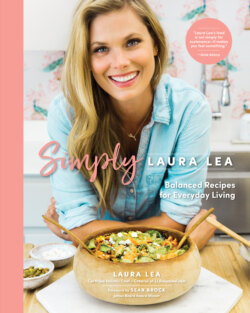Читать книгу Simply Laura Lea - Laura Lea - Страница 45
ОглавлениеLong-Soak Method for Soaking Nuts: Add nuts to a bowl and cover with filtered water by at least 1 inch. Allow to sit in a shaded area at room temperature for anywhere between 8 and 14 hours, before rinsing and draining.
Short-Soak Method for Soaking Nuts: Add nuts to a saucepan, and cover with 2 inches of water. Bring to a simmer, and simmer two minutes, then drain and rinse with cold water.
Nut and Seed Butters: I use unsweetened, unsalted
nut and seed butters in my recipes. I also try to use
newer, runnier nut and seed butters, because they
add moisture and are easier to blend. If that’s not an
option, try this trick: Scoop out a few tablespoons
less than the recipe calls for and place in a mixing
bowl with the missing amount of very hot water.
Stir to combine, then allow the mixture to sit for
10 minutes. Stir thoroughly and measure out the
amount needed for the recipe.
Salt: When I call for salt throughout the book, I am
referring to fine-ground, noniodized sea salt. This
is the ideal all-purpose salt for cooking, baking,
and seasoning. Sea salt retains beneficial traces
of minerals. Do not substitute table salt, which is
even more finely ground; using the same amount of
table salt will result in a dish that’s overly salty. For
finishing or garnishing, I recommend sea salt flakes
(Maldon sea salt) and pink Himalayan sea salt.
Aged Balsamic Vinegar: I specify “aged,” because
it is slightly thicker, richer, and sweeter than
regular balsamic vinegar, and the two really aren’t
interchangeable. You can also “age” it yourself by
taking regular balsamic vinegar and heating it to
a simmer in a small saucepan. Simmer, stirring
frequently, until its volume has reduced by about
one third. Allow to cool completely before using, and
store in the fridge.
Butter: All butter used in recipes is unsalted. If
possible, purchase butter from grass-fed cows.
Quinoa: All quinoa cooks the same regardless of
color, so just use whatever you can find. Be sure
to follow rinsing instructions to avoid a soapy
aftertaste.
Scallions or Green Onions: They’re the same thing!
The recipes refer to them as scallions, but some
grocers refer to them only as green onions.
Avocado Ripeness: An avocado is ripe if it gives
somewhat easily when you press it with your thumb.
If it feels almost hollow and gives very easily, then
the avocado has started shrinking away from the
skin. It is likely too ripe and may be going bad. If
you purchase an underripe avocado, store it in a
brown paper bag on the counter with a piece of cut
fruit to expedite the ripening process. You can store
perfectly ripe avocados in the refrigerator for a
couple of days without them ripening further.
Peeling Fruits and Vegetables: If I am using
produce that is on the Dirty Dozen list, I always
peel as the skin holds a high concentration of
pesticides. If it’s organic or not one of the Dirty
Dozen, I usually don’t peel.
Prepping Kale and Collard Greens: To slice the
leaves into ribbons, first rinse the leaves and pat
dry. Lay a leaf flat on the cutting board. Holding
the leaf with your non-dominant hand, use a sharp
knife to slice on either side of the thick part of the
stem (usually almost to the top of the leaf). Remove
stem. Repeat with remaining leaves. Then layer a few
leaves on top of each other, and roll into a log shape.
Slice crosswise into ribbons.
